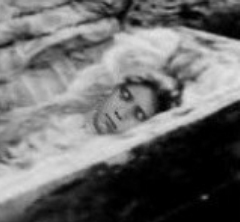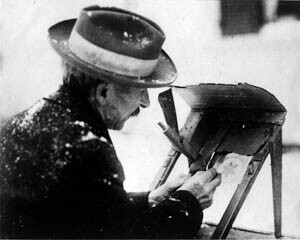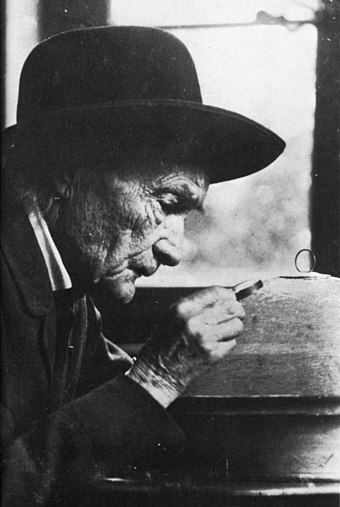Kathryn Griffin Swegart's Blog, page 5
April 27, 2023
Carnage in the Tulip Patch
 ….the hope…..
….the hope…..Hope springs eternal in the hearts of gardeners. In October, we planted 200 tulip bulbs in our door yard (Maine talk for the front yard). I fell to my knees and dug deeply into the soil with my garden trowel. Visions of red and yellow tulips danced in my head. Oh, how lovely they will look bobbing in the spring breeze.
Winter snows melted away in April. To my surprise, tulips sprouted beneath the snow. Do plants really grow under the snow? Miracles are everywhere. My heart swelled with joy. Soon tulips would shine in the bright spring sun.
One morning I opened the back door and breathed in the warm air. Oh, what a glorious morning. I glanced over at the tulip patch and groaned at the sight.
I called to my husband. “Robert, a deer trampled in the garden. It ate the tulips!”
“Are you sure it was a deer? It could have been a groundhog,” he responded.
I ran over to the garden and saw hoof marks that sank into the soft soil. The deer had sheared off dozens of plants and dug up some bulbs. I visualized the rampage occurring while I slept blissfully in my cozy bed.
 …the reality…
…the reality…Anger overtook my thoughts. Somehow, I would save the remnants growing bravely in the soil. I tried an organic repellent that was “effective and long lasting.” The nasty odor would turn away deer, rabbits, and even elk. I mixed the powder concentrate in water and used a special sprayer to douse the plants. Within an hour, my hands were covered with a brown stain. I did not care. I would defeat the invader.
The next morning, I eagerly looked at the garden. The deer had returned and lopped off more tulip tops. It seemed to enjoy the smell. Only a dozen plants remained. What was my next battle tactic? Just then I noticed a small blue tarp near the barn. That’s it! At night I covered the remaining plants and removed the tarp in the morning. Evidently, I skunked the deer. They could not figure out how to get under the plastic cover.
I guess gardeners must be grateful for what pittance enemy forces allow us to have in our war chest. After all, 12 flowers out of 200 isn’t so bad.
Note to groundhogs. Tasty lettuce leaves will be out in the garden soon.
The post Carnage in the Tulip Patch first appeared on Kathryn Swegart.
March 21, 2023
Mystic Lake

On the Solemnity of the Annunciation

My dear husband can, at times, be a puzzling gentleman. Perhaps you can relate to this statement. I present to you a case in point.
On the Solemnity of the Annunciation, he wished to celebrate the feast in a unique way. He conjured up the perplexing idea of having a picnic. That may sound fine to you, but we live in central Maine, near the Canadian tundra. Technically, spring had arrived. A peek out the window told a different story. Clouds shrouded the sky and temperatures were a chilly 45 degrees. Heavy mist hung over the lake, still covered with ice.
“Let’s have supper at the lake!” he declared.
Now that is a surprising announcement considering his dislike of cold weather. Still, I ( grudgingly) packed a simple meal in the wicker picnic basket and we drove off for our next adventure. Thus began a dreary hour in which I wrapped myself in a blanket and munched on sourdough bread. All was solitary until a majestic bald eagle soared overhead and swooped down on us in search of fish carcasses. My husband gasped in delight and tried to capture the moment on video.
Attention now shifted westerly to dense, low-lying fog that floated over the ice, undulating in patterns, drifting like ghosts. I was intrigued, but soon it was time to pack up and leave. We drove home in silence as I pondered how this wintry picnic celebrated the Annunciation. That night I got my answer.
At dawn I woke up with a start. Images of the mystical fog came to mind. Yes, white fog hovered like the finger of God, real as that Incarnate moment of the Annunciation and of Mary’s Magnificat.
The post Mystic Lake first appeared on Kathryn Swegart.
February 21, 2023
The Death of Jacinta

February 20,1920 A hospital in Lisbon, Portugal
Jacinta Martos was only nine years old when she lay dying in a hospital, far away from her family. Her diagnosis was purulent pleurisy. Nurses bustled around the hospital ward, comforting patients. Jacinta listened to patients groaning, but she was silent. Doctors had removed three infected ribs, using only local anesthesia to dull the pain. Few of the nurses knew that she was one of the three visionaries who witnessed the visits of Our Lady to Fatima. Few knew that Jacinta was told by Our Lady that she would die alone in a hospital in Lisbon. In a vision, she was given a choice. Did she want to go to heaven soon or endure more suffering? The little girl decided to offer her intense suffering for the conversion of sinners.
Jacinta died on February 20, 1920, comforted only by her love for Jesus and Our Lady. Four days later, she was buried in a little cemetery in Ourem, surrounded by grieving friends and family. A simple white tombstone was erected over the resting place of Jacinta and her brother, Francisco, who died of the Spanish flu just one year after witnessing the apparitions. A brief inscription was engraved on the stone:
Here lie the mortal remains of Francisco and Jacinta to whom our Lady appeared.
They were laid to rest amid the mountains and fields of a little hamlet in Portugal. They were not forgotten. For ten years, witnesses to the miracle of the sun were interviewed and further investigations conducted. On October 13, 1930 the local bishop granted formal approval of the 1917 apparitions, declaring them “as worthy of credence.”
Five years later, the local bishop decided to move the children’s remains to a new burial spot in front of the church in Fatima where the children had been baptized. A crowd gathered around the caskets. The bishop opened the lids as part of the transfer. As sunlight fell on Jacinta’s face, the bishop took a deep breath. Jacinta’s body lay there, almost perfectly preserved.

There is more to this story. Someone snapped a photograph of the phenomenon. Eventually, the bishop sent a copy of the photo to her cousin Lucia, who also witnessed the six apparitions. She was now a religious sister cloistered in a Carmelite convent. As you can imagine, seeing the face of her beloved younger cousin stimulated many memories of Jacinta. Lucia sent a letter to the bishop describing her cousin in detail. The bishop was so impressed with Lucia’s letter that he told her to write down memories of Jacinta.
Under obedience to the bishop, Lucia wrote three memoirs that gave detailed eyewitness accounts of the famous visits of Our Lady to Fatima in 1917.
Jacinta and Francisco were canonized on May 13, 2017. Their feast day is celebrated on February 20.
The post The Death of Jacinta first appeared on Kathryn Swegart.
January 25, 2023
Thoughts by the Woodstove


Winter mornings in Maine are dark and bitter cold, hard as ice on the body and soul. I arise before dawn, eager for a steaming mug of hot tea. That must wait. My first task is to start the wood stove. I open the door and check for embers. On this snowy morning, all looks black — not a spark to be seen. Even the stove is cold to the touch. I have no hope that the kitchen would be warm anytime soon. With a sigh I gather twigs from a paper bag. I hold a small iron shovel and shuffle coals around, doubtful that I will stir up any sparks. Surprise! I look closely and see a faint glow. Encouraged, I stack twigs, kindling, and newspaper, strike a match and a flame lights the darkness.
Now this may seem like too much work for most people. Indeed, it is a chore, but it is all worthwhile. I will tell you why. A wood stove delivers more than heat. It delivers the crackle of kindling and the sweet smell of burning oak. It delivers a cozy spot to read a book. Mysteriously, the flames have a mesmerizing effect, encouraging me to reflect deeper, beyond just staying warm. As I carefully add sticks onto a small bed of coals, I think of people I love who have left the Church. Deeply immersed in secular society, they lack awareness that life has a transcendent quality. St. Paul reminds us,
What is seen is transitory, but what is unseen is eternal. (2 Corinthians 4:18b)
Sometimes I lose hope for these loved ones that the light of faith is dead. I pray for them, strive to be a charitable person, and every now and then spark a gentle conversation about the existence of God. Often, it feels like a dead end. Still, I don’t give up. Recently, I read Night’s Bright Darkness: A Modern Conversion Story by Sally Read. Her story gave me hope. After the death of her father, Sally felt disoriented. All meaning in life was lost, by all appearances her heart seemed dead to change but one night, the unexpected happened. Alone in the world, Sally remembered words from a book, words that had a strange effect on her. It read, “God is merely shorthand for where we come from, where we are going, and what it’s all about.” Suddenly, Sally thought there was a possibility that God existed. One word started a chain of events that led to her conversion to the Catholic faith — all in just one year.
I take that first glorious sip of hot tea on a cold day and feel a glimmer of hope. A small ember can start a fire in my wood stove, just as heartfelt prayers, charity, and sweet reminders of our eternal destiny can start a soul back on the path to Christ and His Church.
The post Thoughts by the Woodstove first appeared on Kathryn Swegart.
January 3, 2023
Merry Christmas…Still Applies!
Reflection from Christmas past…


It was to be a quiet Christmas, with our farmhouse deep in snow and a blizzard bearing down, tracked by radar from the Kansas prairie. Treacherous road conditions cut us off from civilization. At noon on the day before Christmas, a dim sun rose, rimmed with a dark circle — an ominous sign. Bitter winds blew from the east. Our son made it home in time to help us bring wood on the porch. Bedtime came early that Christmas Eve. I felt the old house shake as gales blew across the field. Snow drifted on the windowpanes and piled up on our door posts in shapes spooky as sheeted ghosts. Pulling blankets over my head, I fell into a deep sleep.
I awoke on Christmas morning to a new world, filled with glistening light under the rising sun. Gone was the brush pile, now covered with a white dome of snow. We sipped hot coffee and ate fresh cranberry bread, gearing up for shoveling. The air was crisp and clean under a cloudless blue sky. Thanks to the strong arms of my son, we cleared a path to the car and leaned on our shovels. We looked at each other and knew what we would do that afternoon. We would strap on snowshoes and hike in the woods behind our house.
I felt exhilarated by the woods after a blizzard. I listened to the swish of my snowshoes through powdery drifts. Dark-green fir trees stood laden in dazzling crystal snowflakes. Wisps of wind blew snow off the branches into my face. We plowed through deep drifts and stopped at an old pine tree. I heard scratching high up in the uppermost branches. A little critter looked down at me. It was a flying squirrel that leaped off the trunk and swooped in front of my face. It startled me.
Startle is good on Christmas morning. After all, the Incarnation is a shocking event. God became Man and dwelt among us. Catholic convert and novelist Annie Dillard agrees. She hears bland sermons, observes lackadaisical parishioners and feels puzzled, wondering if people believe a word of the Gospel. She writes, “It is madness to wear straw hats and velvet to church; we should all be wearing crash helmets. Ushers should issue life preservers and signal flares; they should lash us to our pews.”
That night I turned on the white candle lights that sit on our windowsills. Colored lights twinkle on our Christmas tree, decorated with ornaments, reminding me of a birth in our family or the death of a loved one. Even as a child, these rituals made me think of the interplay of darkness and light, of good and evil that played out on that first Christmas day. Even as Jesus lay in the manger, Herod made plots to kill him. The Holy Family had no time to linger at the stable. They fled for their lives.
It is all so fabulous and strange! I snowshoed in the winter woods, touched by the beauty of God’s creation, surprised by the wonder of Christmas Day.
The post Merry Christmas…Still Applies! first appeared on Kathryn Swegart.
December 14, 2022
Happy 70th Birthday Charlotte!

Let us tip our hats to Charlotte’s Web, one of the most beloved children’s books of all time. Written by E.B White, Charlotte’s Web was published in 1952 and immediately was deemed a classic. One reviewer wrote.
What the book is about is friendship on earth, affection and protection, adventure and miracle, life and death, trust and treachery, pleasure and pain, and the passing of time…What it all proves…is that human beings must always be on the watch for the coming of wonders…As a piece of work it is just about perfect.
Where did E.B. White (who went by the name Andy) get the idea for his famous story?
Andy lived on a farm in Maine immersed in the rhythm of the seasons and caring for animals. One day, his pig took sick and died. If only he could have saved the pig’s life! Another idea flickered in his mind. If only he could write an animal story in which a pig was miraculously saved.
Knowledgeable about spider webs that hung in the barn, White began to research the life cycle of spiders. Could a spider save the life of a pig?

In October 1949 he wrote to his publisher: “My next book is in sight. I look at it every day. I keep it in a carton, as you would a kitten.”
By 1951, the rough draft was completed and put aside to “ripen”.
His handwritten draft shows how he struggled with the first line.
#1 Charlotte was a gray spider who lived in the doorway of a barn.
#2 I shall speak first of Wilbur.
#3 A barn can have a horse in it, and a barn can have a cow in it, and a barn can have hens scratching in the chaff and swallows flying in and out through the door but if a barn hasn’t got a pig in it, it is hardly worth talking about.
#4 At midnight, John Arable pulled his boots on, lit a lantern, and walked to the hog house.
#5 Where’s Papa going with that hand ax?
Finally, he refined the famous first line. Where is Papa going with that ax?
Revisions took another year. Garth Williams was hired to illustrate. He struggled to create a loveable spider face.
Charlotte’s Web went on to win the Newbery Honor, one of the highest awards in children’s literature. Andy recorded the audiobook, using seventeen takes to read the chapter “Last Day” when Charlotte dies. The recording is still sold on the internet.
“It’s ridiculous,” he commented, “a grown man reading a book that he wrote and being unable to read it aloud because of tears.”
The book has sold more than 45 million copies and has been translated into 23 languages.
Here’s an idea for a Christmas present. Buy Charlotte’s Web for a child you know. Perhaps you can read it aloud to that child. If you cry at the end, E.B White would understand.
The post Happy 70th Birthday Charlotte! first appeared on Kathryn Swegart.
December 6, 2022
The Miraculous Journey of Mary’s House‘Tis the season for...

‘Tis the season for many celebrations on the Catholic calendar. We honor the Immaculate Conception on December 8, St. Juan Diego on December 9, Our Lady of Guadalupe on December 12, and the Nativity of Our Lord on December 25, to name a few. One feast day that is easy to overlook occurs on December 10. In 1624, Pope Urban VIII declared that day as the Feast of the Translation (movement) of the Holy House of Mary. Behind this celebration is the story of the miraculous journey of Mary’s house from Nazareth to Italy.
Eight hundred years ago, Christians were under attack by the Saracens, who often destroyed churches. Among the holy sites threatened was the house where the Blessed Mother grew up, also the place of the Immaculate Conception, the Annunciation, and the humble dwelling of the Holy Family. In the year 1291 a strange thing happened in the little town of Nazareth. On the morning of May 10, people of the village were astonished to see that the sacred house had disappeared. All that remained was its foundation.
With no other explanation possible, many came to believe that the movement was of supernatural origins. On that day in May, the little house inexplicably appeared on hillside in Tersatto, Croatia. It stayed there for three years. Next, the house was lifted over the Adriatic Sea to Italy. After two more moves, it was mysteriously relocated to its current location in Loreto, Italy.
Why would a sensible person believe such a fantastic story? Let’s take a closer look. Scientific studies of construction materials show that the foundation (located in Nazareth) and the house match perfectly. Stone from the Holy House in Loreto is made of limestone, not red volcanic rock found in Italy. Dimensions of the foundation and dwelling are a perfect match.

Over the centuries, many faithful Catholics came to believe that angels moved Mary’s house. You might wonder who would believe such a story. We turn to Catholic history for an answer.
Popes over the centuries have encouraged veneration of the Holy House. Many saints have visited the pilgrimage site in Italy. Among those saints were Francis of Assisi, Francis Xavier, Charles Borromeo, and Thérèse of Lisieux. In 1848, St. John Henry Cardinal Newman made a pilgrimage to Loreto and left with no doubt of the miraculous nature of the house: “If you ask me why I believe, it is because everyone in Rome believes.”
By the year 1917, 44 popes had visited and expressed belief in the miraculous origins. Among those popes were Leo XIII, Pius X, and Pius XII. In 1950, Pope Pius XII elevated the House of Loreto to the status of holy place. In 1993, Pope Saint John Paul II called it “the foremost shrine of international import dedicated to the Blessed Virgin.”

Generations of artists and architects designed a magnificent basilica that was built over the humble house. Devotion spread far and wide. In 1920, Pope Benedict XV declared Our Lady of Loreto patroness of aviators. In 1927, Charles Lindberg carried a statue of Our Lady of Loreto on his historic flight from New York to Paris, when he became the first pilot to fly solo across the Atlantic Ocean.
The post first appeared on Kathryn Swegart.
November 17, 2022
First Snow

Way up north in the woods of Maine we had our first snow. For most of us, it was a wake-up call that winter is here. Snow blankets our garden, tucked to bed in the warmth of October days. We planted 200 tulip bulbs and patted the soil in a sign of farewell. My husband planted winter wheat that grew in the rich composted soil. Green sprouts waved in the wind. Could a plant really grow in late autumn here in New England?
Our warm, sunny fall felt like a trick. New Englanders waited for the other shoe to drop, for the Montreal Express to bluster into town. That expectation is always met.

So now I must look for new beauty, like William Bentley who was born on a farm in Vermont on February 9, 1865. He is famous for taking the first photograph of a snowflake. William Bentley said snow was as beautiful as butterflies, or apple blossoms.
He wrote these words.
Of all the forms of water, the tiny six-pointed crystals of ice called snow, that form in such quantities within the clouds during storms, are incomparably the most varied and beautiful.
I must put on the mind of William Bentley. I must stop and study snowflakes glistening on an evergreen bough, white as stars, tiny megaphones of God’s creation.
The post First Snow first appeared on Kathryn Swegart.
November 2, 2022
The Unexpected Hitchhiker

Life is full of surprises, as you have probably noticed, some big and some small. I think of a startling moment that occurred on a day not so long ago.
My husband pulled up at the drive-up window of our local bank. Just as the teller greeted us, a gray field mouse popped up on the car window and studied us with his shining black eyes. He wiggled his delicate whiskers, picking up clues to his whereabouts. I yelped (as is my custom when encountering a mouse) and the bank teller laughed heartily. Mousekin darted back under the hood to continue his pleasant ride into town.
A little research in my favorite science book, Handbook of Nature Study by Anna Comstock, revealed that mice like to travel, following men wherever they go, all over the world. Here is what Comstock had to say.
They came to America on ships with the first explorers and the Pilgrim fathers. They now travel back and forth, crossing the ocean in ships of all sorts. They also travel across the continent on trains.
I do not know where Mousekin is now. Perhaps he hitched a ride to the local airport and flew down to Boston. Maybe he caught an international flight to Italy and is getting his first taste of genuine Italian gelato.
I reflect on this episode and know for sure that life is full of little miracles. All we need to do is open our eyes and minds to those unexpected moments that fill the complex tapestry of our lives.
The post The Unexpected Hitchhiker first appeared on Kathryn Swegart.
October 18, 2022
Jean-Henri Fabre (1823-1915)

How Catholic Scientists/Inventors Help Build Western Civilization
Picture a field of wildflowers growing in a pasture located in southern France. The year is 1830. A boy named Henri crawls through the field spying on a butterfly. He watches with a keen eye as the butterfly lands on a flower and sips nectar. The boy’s name is Jean-Henri Fabre and would grow up to be a self-taught scientist famed for his field studies of insects.
Born to a poor Catholic family living in an isolated farmhouse, Henri spent many hours studying the anatomy and behaviors of insects. Thus began a lifelong fascination with the natural world. Scientists now call him the father of entomology (the study of insects).
Unlike other scientists who studied dead insects, Henri was devoted to the study of live specimens. Combined with his skill as a popular writer, Favre brought strange insect worlds to the public. He wrote about the habits of dung beetles and the paralyzing instinct of solitary wasps, to name just a few.

One biographer called him the Poet of Science: a tribute to his enchanting style of writing. Fabre’s life-long dream was to acquire a swatch of land that would become his laboratory. One day his dream came true. He described the land as desolate, barren, sun-scorched bit of land, overgrown with thistles and much loved by bees and wasps.
In one experiment, he created a continuous loop of caterpillars around the edge of a pot. The caterpillars crawled in circle for seven days, demonstrating the important principle of instinct in nature. Fabre also could predict low pressure by observing caterpillar behaviors.

Tourists can visit a museum in France dedicated to insect study, built on the site of Fabre’s birth. His insect collection is preserved at the museum in Avignon.
The post Jean-Henri Fabre (1823-1915) first appeared on Kathryn Swegart.



